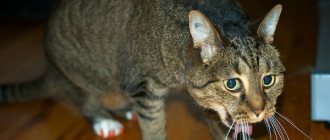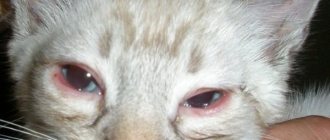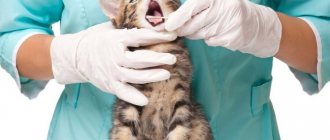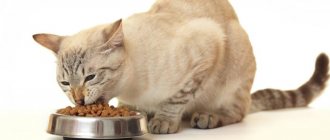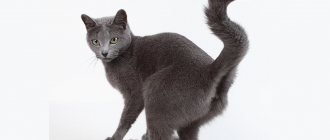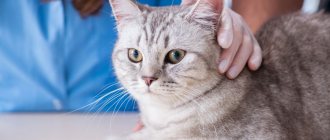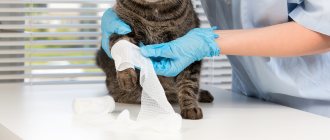When a pet is sick, its owner also suffers. Especially if the cat is vomiting. Of course, at such a moment you want to help your pet as quickly as possible, to alleviate his suffering. However, it should be understood that vomiting acts as a kind of protective reflex of the body. Using this process, harmful substances are removed. It is important to take into account that vomit often differs in composition and appearance. The presence of yellow liquid should be a cause for concern.
Of course, self-medication in such a situation is inappropriate. You should immediately rush to an experienced veterinarian. He will conduct a full examination of the animal and determine the cause of the disease. True, at the first urge to vomit, you should not rush to the doctor. However, if vomiting occurs for several days in a row, or the animal experiences frequent spasms, then urgent consultation with a specialized specialist is necessary.
The main causes of vomiting bile
To correctly make a diagnosis, you should pay attention to the factors that provoked vomiting in the cat. It is also important to record the time of the cat’s first vomiting and determine the frequency of vomiting. The main reasons why a cat vomits yellow liquid are presented below.
Vomiting bile in a cat is the first sign of a serious illness
- Presence of a foreign body in the stomach. During play, a pet may swallow a small object, which causes blockage of the esophagus or stomach. If the size of the eaten object is very small, then most often it leaves the body along with the feces. If a larger part is swallowed, the body starts the process of increased secretion and production of bile acid, which are aimed at dissolving various objects in order to speed up the digestion process. Excess bile leaves the body in vomit.
- Change of diet. If the calorie content of a pet's daily diet has increased sharply, then the pet begins to suffer from liver problems. Hepatocytes become unable to quickly adapt to a new regime. This is evidenced by vomit, colored yellow, with the presence of foam, pink mucus and undigested parts of food.
- Parasitic infestation. Severe helminthic infection of the body leads to serious disruption of the digestive system. The cat is vomiting bile and has no appetite. Thus, the body independently tries to get rid of worms.
- Digestive system disorders occur due to rapid absorption of food. Often, such a nuisance can arise from feeding a cat food of poor quality, fatty foods. Bile, produced by the body in large quantities, leaves the body along with the vomit.
- Inflammatory process of the structural components of the liver. Often, when cats vomit yellow foam, veterinarians diagnose hepatitis in cats. In this case, the mucous membrane looks yellowed, the four-legged friend refuses to eat, and the body temperature rises. The urine may darken and problems with bowel movements may occur. In addition to hepatitis, doctors often diagnose liver failure, in which the cat vomits bile and an unpleasant odor emanates from its mouth.
If bile is detected in the vomit, you should immediately seek help from a specialist.
- Lipidosis is a pathology associated with the accumulation of excess fat in the liver area. The functioning of organs is disrupted, and toxic substances begin to accumulate in the body. The animal suddenly loses weight and completely refuses even its favorite food. Due to lipidosis, the cat has yellow vomit. The pet is weakened and spends most of its time hidden in a secluded place. It is important to give the animal something to drink as often as possible, even if the cat runs away. This will help you avoid dehydration.
- The presence of heartworms, along with disturbances in the functioning of the thyroid gland, can cause vomiting of bile in an animal.
- Pathologies of the gallbladder provoke the appearance of yellow vomit in a cat. In this case, the vomit contains a pronounced aroma of bile. In some cases, diarrhea mixed with blood and bile may occur.
- A history of infectious diseases such as herpes, rhinotracheitis, etc. The cat suffers from weakness, yellow vomiting and watery diarrhea. Vomiting can occur both on an empty stomach and after eating. It is necessary to seek help from a doctor as soon as possible.
- Postoperative period. Complications that occur during this period of time can cause yellow vomiting mixed with foam, green/brown mucus and blood. The cat's health is deteriorating. He becomes lethargic and his nose is dry. The fur becomes matted. It is important to immediately take your pet to a veterinarian, who will prescribe the appropriate treatment.
- Pregnancy. During this period, cat pathologies worsen. Vomiting of bile may indicate diseases of the gallbladder and ducts. The cat may vomit all the food it eats.
Note! An animal suffering from vomiting bile needs to be examined by a veterinarian and receive medical attention.
What explains the presence of yellow color
Vomiting bile is a pathology that indicates the accumulation of a large amount of bile in the stomach area. Bile is a powerful reagent that can corrode the gastric mucosa. Often, bile accumulated in the stomach provokes an inflammatory process in the digestive system and the development of ulcers.
Symptoms
Vomiting in a cat that is yellow in color, even once, is a reason to contact a veterinarian, as it is a serious symptom indicating a disruption in the functioning of the body.
You should immediately go to the clinic if your pet experiences repeated vomiting with bile and bloody clots, concentrated with mucus. Such symptoms indicate intestinal volvulus, perforation of the stomach by an ulcerative lesion, or the disintegration of a malignant tumor in the area of the intestinal loops.
In case of fountain vomiting (when it is not possible to leave the house with the animal), it is necessary to call a doctor at home. The younger the animal, the higher the risk of dehydration during prolonged bouts of vomiting.
In addition to the fact that the cat is vomiting bile, other characteristic symptoms may be observed:
- breathing problems;
- profuse diarrhea;
- febrile conditions in the animal;
- coma in a cat;
- swelling in the peritoneum;
- sudden weight loss;
- the cat refuses to drink water and does not eat (symptoms indicate intestinal volvulus).
It is problematic to independently identify the cause of what is happening, and prescribing independent treatment is also dangerous for the animal’s life. Any delay in providing qualified assistance to a cat can cost it its life.
When contacting a veterinary hospital, the veterinarian conducts a general clinical examination and collects a detailed medical history. The medical history must indicate what the animal ate on the eve of vomiting and whether there are any chronic diseases.
In some cases, the doctor may only need a clinical examination and history taking. But in the vast majority of cases, serious examinations are required to make an accurate diagnosis. Accurate diagnosis includes:
- ultrasonography;
- radiography of liver structures, gallbladder and intestinal loops;
- computed tomography for suspected tumor processes;
- endoscopy to exclude inflammation in the stomach and duodenum;
- general blood and urine analysis;
- examination of vomit samples.
What should an owner do if a cat is vomiting?
When your cat vomits yellow liquid, don't panic. One-time vomiting is not dangerous for the animal. If vomiting occurs systematically, it is necessary every 20-30 minutes. pour a large amount of liquid into the oral cavity. When pets vomit, they lose moisture, which causes dehydration. There is no need to feed the cat at this time.
The dog is vomiting yellow foam with liquid: why does this happen?
It is important to get to the veterinary clinic as soon as possible to show your pet to a specialist. Self-medication in such a situation is unacceptable. Anti-vomiting drugs that are used to treat people should never be given.
Note! If vomiting continues for 5-10 hours, you should immediately call a veterinarian or take the cat to the clinic yourself.
The symptoms described below indicate the need to immediately visit a veterinarian to examine the disease.
- Prolonged vomiting that lasts more than 5 hours.
- The presence of blood clots and bile in the vomit.
- Increased body temperature, accompanied by strong yellow vomit.
- Decreased physical activity, refusal of any food and water, which is accompanied by severe vomiting mixed with bile.
- Systematic vomiting in an animal, regardless of food intake.
Yellow foam and vomiting - what does it mean?
Symptoms are characteristic of panleukopenia. Most often, unvaccinated kittens suffer. The infectious disease is highly lethal and requires seeking veterinary care.
Another reason is no less dangerous - poisoning with anticoagulants, which are used to poison rodents. The cat owner is unable to make an accurate diagnosis. Only a veterinarian in a clinic will conduct laboratory tests, ultrasound and other studies and prescribe treatment.
What to look for if your cat is pregnant
The cat is vomiting white foam and saliva: what to do?
Burping in a pregnant cat should not be a cause for concern. During this period, it is acceptable that she will vomit systematically. If an animal bearing offspring suffers from vomiting mixed with bile, it must be shown to a doctor. Often, such symptoms indicate severe intoxication of the pet’s body.
When your cat is vomiting, you need to give more water.
It is important during the period when your furry friend is bothered by the urge to vomit, to take even more care of his health. You should pour water into your cat's mouth as often as possible. The cat menu needs to be changed. It is best to offer dietary wet food. Food is served in small portions every 4 hours, which will avoid irritation of the inflamed stomach.
If a pregnant cat is vomiting every 30-60 minutes, it is best to limit what she eats. In this case, water is poured into the oral cavity often, but in minimal portions. The situation is especially dangerous when, in addition to vomiting, the cat begins to have diarrhea. In this case, the animal’s body loses a large percentage of moisture.
Important! In addition to drinking water, your cat can be given small portions of chamomile decoction, which has a calming effect on the stomach.
What causes the yellow color?
The yellow color of vomit in cats is due to the presence of bile in the corresponding secretions. If a pet has no health problems, then bile acids are not found in the stomach. They appear in pathologies of the duodenum. Vomiting yellow liquid is often life-threatening for the animal. Bile secretions provoke severe irritation of the gastric mucosa. This is fraught with the formation of all kinds of inflammatory processes.
The yellow color of vomit is a direct indicator of bile reflux directly into the stomach. This symptom is characteristic of diseases of the small intestine, hepatitis, gastroduodenitis. It is important to understand that each owner is responsible for the health of their own pet. Therefore, in order to avoid an irreparable situation, it is advisable to follow preventive measures and monitor the mood and condition of your pet.
Animal treatment
When a cat vomits bile, it is necessary to visit a veterinarian as soon as possible, who, after examination, will identify the cause of the unpleasant condition and prescribe the appropriate treatment. Often cats that vomit yellow suffer from:
- liver cirrhosis;
- hepatitis A;
- hepatosis;
- gallstone disease;
- cholecystitis;
- liver failure.
The dog is vomiting white foam: reasons and what to do
Depending on the diagnosis made by the veterinarian, treatment will be drawn up aimed at eliminating the cause of the ailment.
For hepatitis of a toxic nature, which can be caused by low-quality food or poisoning by a poisonous plant or medication, veterinarians prescribe:
- glucose infusion;
- injections of thiamine and insulin;
- taking medications like Vikasol, aimed at restoring blood clotting;
- taking medications such as holosas, aimed at maintaining liver function.
To treat infectious type hepatitis, which occurs against the background of viral infections and parasitic infestations, a special diet and immunostimulants are prescribed. In addition, the veterinarian prescribes:
- antispasmodics;
- antibiotics;
- Vitamin preparations are the main condition for the treatment of any pathology.
When diagnosing hepatosis, it is advisable to use drug treatment in combination with a special diet. Animal fats in the cat's menu are kept to a minimum. A diet containing a high percentage of protein helps stabilize the furry patient’s condition.
Note! If, in addition to hepatosis, the veterinarian has discovered diabetes mellitus, therapy is prescribed to the cat that is belching bile, on an individual basis, taking into account the characteristics of the body.
Yellow vomit in a cat can signal the development of gallstone disease. The therapeutic goals in this case are based on the use of thermal procedures that help relieve spasms. In addition, it is advisable to give your pet medications that have a choleretic effect. If there is a large formation of stones that block the bile ducts, it is necessary to urgently carry out surgical intervention. In this case, stones are crushed using ultrasonic waves.
Diagnosis of liver failure requires immediate treatment. Cats that vomit both water and bile need:
- relieving the cause of the pathological condition (antimicrobial and hormonal agents are used for this purpose);
- removing toxins from the body;
- regulation of the process of mineral metabolism;
- monitoring the functioning of the heart;
- special diet.
A cat can vomit yellow foam for many reasons.
If you notice vomiting of bile in your pet, you should immediately go to see a veterinarian. Self-medication can cause irreparable harm to your pet's health. For example, the presence of a foreign body in the digestive tract will not resolve on its own. Lack of timely qualified assistance can lead to the death of the animal.
Taking antiemetic medications purchased from a human pharmacy is often ineffective. After all, for proper treatment, you should undergo a diagnosis that will help identify the true cause of the animal’s serious condition.
There are situations when it is unacceptable to hesitate, because the life of a pet is at stake. The most common ones are described below.
- Ingestion of a chemical such as turpentine, solvent, acid. In this case, it is important to immediately pour 1 tbsp into the cat’s mouth. spoon of enterosgel and call a veterinarian immediately.
- Presence of blood in the vomit. The owner of the animal must immediately give 1 tbsp. a spoonful of Vaseline oil to a sick pet.
- Continuous vomiting for 5-7 hours. It is recommended to administer cerucal intramuscularly (0.1 ml per 1 kg of body weight).
Note! If you help an animal in a timely manner, you can save its life.
Possible diseases
Isolated cases of bile vomiting in cats do not require the help of a veterinarian. Most often they occur due to overeating. In this case, it is enough to adjust the pet’s diet.
Repeated attacks with foam and bile indicate the onset of an inflammatory process in the gastrointestinal tract. This could be a stomach ulcer, gastritis, pancreatitis and other diseases. A veterinarian's consultation is required to make a diagnosis.
White vomit is a consequence of prolonged fasting. It occurs due to the reaction of stomach mucus to oxygen. The animal cannot be fed abundantly at once; portions are given frequently and in small quantities.
Yellow vomiting with blood and foam is an alarming symptom. It appears when there is bleeding in the esophagus, intestines or stomach. With an ulcer or tumor, streaks of blood are present in the mass. Scarlet and homogeneous blood appears when the upper gastrointestinal tract is damaged. This condition requires urgent assistance from a veterinarian.
Vomiting hair in cats
Vomiting that shoots out in a strong stream over long distances requires immediate delivery of the cat to the clinic. The symptom occurs when there is intestinal blockage, high intracranial pressure, or brain damage. Doctor's help required.
In kittens, vomiting occurs due to congenital pathologies of the gastrointestinal tract or low-quality mother's milk. The smaller the cub, the less chance of survival. Kittens from two months of age have a better chance of survival.
A fragile body has a high intolerance to drugs.
If vomiting is accompanied by diarrhea, lethargy, loss of appetite, and fever, then this may be a sign of infectious diseases. Urgent consultation with a veterinarian is required.
What to do for prevention
Cat owners who are faced with a situation such as yellow vomiting ask their veterinarian how they can prevent the recurrence of a complex ailment. Below are the basic preventive measures that every pet owner should know.
- The pet's diet must be balanced. You should buy only high-quality food for cats. It is advisable to use natural products for a kitten.
- There should always be clean drinking water in your cat's bowl.
- Raw meat and fish have no place in the furry diet.
- To store medicines and household chemicals, it is worth choosing places inaccessible to animals.
- It is important to promptly vaccinate pets against infectious pathologies.
- Every 6 months, kittens and cats need to be prevented from worms.
- The cat's fur should be systematically combed with a special comb, which will prevent clogging of the stomach with hairballs.
- Small objects and parts should be removed from the floor away from the cat to avoid swallowing a small object.
Vomiting bile is quite dangerous
If vomiting with bile occurs, it is important to monitor the cat's condition. A one-time urge to vomit should not be scary, but a systematic urge to vomit will be a reason to immediately contact a veterinarian. If, when transporting to a doctor, there are concerns that the cat may vomit, it is advisable to use a plastic carrier.
When to seek help from a veterinarian?
What should I do if my cat has yellow vomit, he doesn’t eat or drink, and these symptoms have lasted for more than a day? If even with first aid your pet’s condition does not improve, you should consult a specialist. You should also consult a veterinarian if the following signs appear: diarrhea, lethargy and apathy, and increased body temperature.
All this indicates that the animal is unwell. In this case, only a veterinarian can identify the causes of the pathology and prescribe the correct therapy.
What is the consistency of foamy vomit?
The appearance of white foamy vomit is considered normal during a long hunger strike or severe stress. In this case, the vomit will not smell unpleasant, and there will be no impurities (except for a small amount of liquid).
If the hairball has accumulated for a long time and stagnated, the vomit may acquire an unpleasant odor. In this case, it is advisable to inspect what the cat burped and make sure there are no bloody or greenish streaks. If they are not there, everything is in order, the body managed itself.
But if you see the presence of impurities or a change in color, feel a sharp unpleasant odor, find blood or strange clots, then it is better to immediately contact a veterinary hospital. A strong, incessant gag reflex will lead to dehydration and exhaustion, so your pet will definitely need your help.
What to feed your cat after vomiting
After the cat has vomited, the attentive owner continues not only to monitor the condition of the purr, but will also offer him dietary food. It does not cancel taking medications, but accompanies it. A fasting diet is required in the first 10 hours. Instead of water, after a single nausea, it is better to let the cat lick a couple of ice cubes. Repeated vomiting dehydrates the cat, so you will have to try to give the cat fresh, clean water to drink.
The diet in this case is therapeutic: the stomach and intestines will react poorly to fatty, spicy and salty foods. If the cat eats dry food, medicinal forms are chosen.
The animal is given rice water, baby purees, and boiled chicken for two days in a row.
